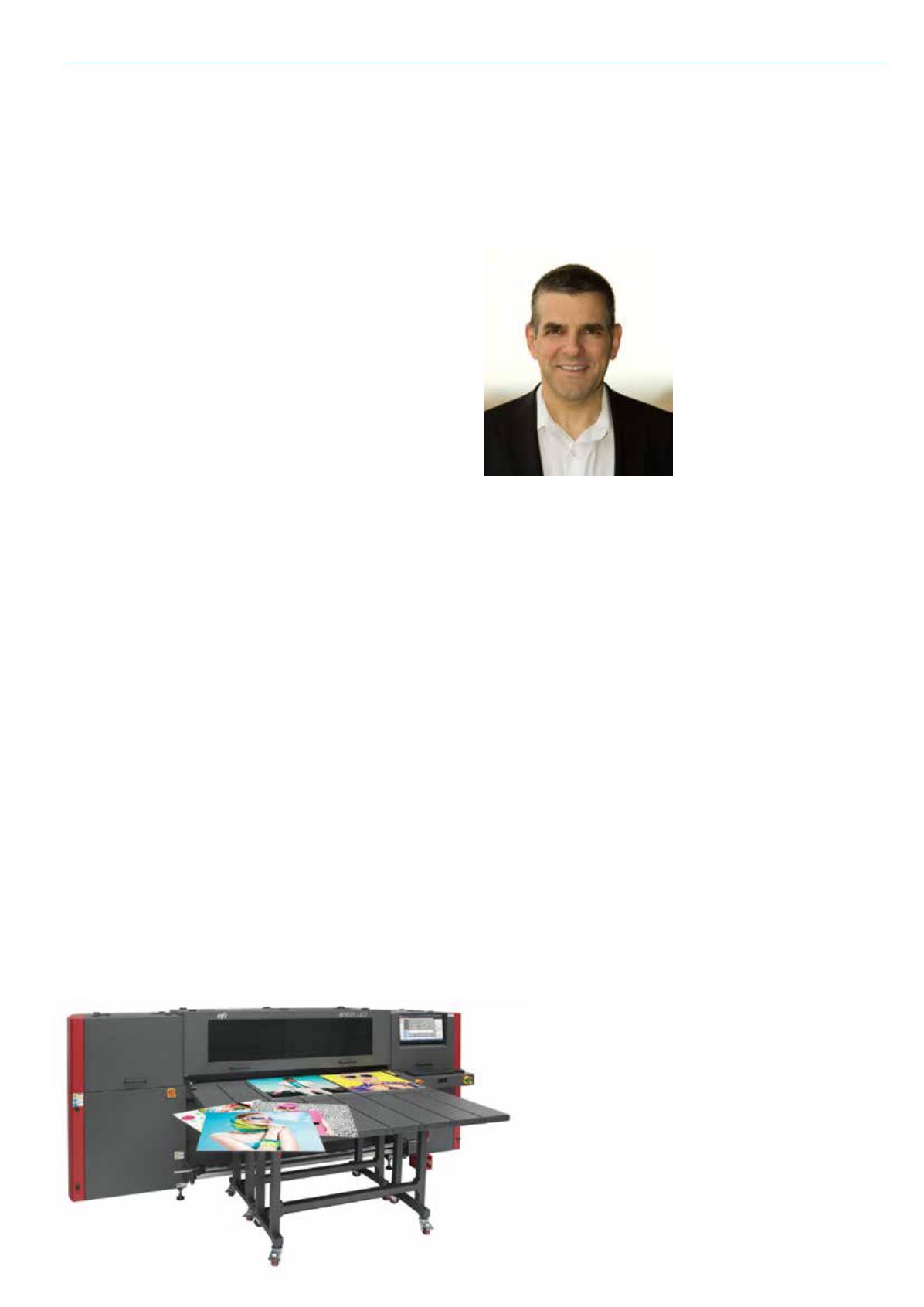
At IPEX,
PrintIT
caught up with Guy Gecht, CEO of EFI, to discuss
developments in production print
Window of opportunity
In this age of smartphones,
tablets, always-on internet
connectivity and the cloud,
it is fashionable and, let’s
face it, just a little too easy
to talk about the decline of
print.
This is not something
EFI CEO Guy Gecht does.
Instead, he prefers to focus
on the ever-moving ‘window
of opportunity’ that exists in
every industry for those with
the vision to look beyond the
status quo. Yes, office printing
is in decline, but there are
still plenty of opportunities for
growth, driven by digital print’s
ability to produce short-runs of
personalised material at high
speed.
“I am an optimist,” Gecht
said. “When I look at my
customers, the majority by a long
shot are doing better than they
did last year, which was better
than the year before that. Digital
printing is going to take over a
great chunk of the market. If you
are in digital printing, you are
going to get more and more jobs.
And it’s more efficient, because
you manufacture on demand.”
He points out that many
applications will never be
replaced by the iPad – “Yoghurt
is always going to have
packaging,” he said.
“There is tons of opportunity
in digital printing in the next
10 or 20 years. You can print
Production Print
on almost any material and
the world around us is full of
imagery. In your lifetime and
your kids’ lifetime, people will
care what’s printed on the floor,
what’s on the table, what’s in
decoration and signage and
what’s on packaging. I think the
opportunity is tremendous.”
Double-digit growth
With four consecutive years
of double-digit growth, EFI is
profiting from this opportunity
mainly because about 10 years
ago it spotted that its original
market of print controllers
for digital copiers was in
decline and that the ‘window
of opportunity’ had moved to
production print.
Today, its prosperity is built
on three product areas that
can be used separately or
together in a complete solution:
Fiery Digital Front Ends (DFEs);
business automation and
workflow software, such as MIS
software and the web-to-print
solution Digital StoreFront
(DSF); and inkjet printers.
Last year, all three segments
grew strongly, but for Gecht,
inkjet printing has the most
potential for growth.
“With inkjet there are
probably more opportunities
to grow faster, because of the
adoption of digital. Inkjet is
a very versatile technology.
Because it doesn’t touch the
material, it lets you do a lot
more. EFI is the only company
that does LED low temperature
curing (see caption), which
allows you to print on essentially
any material. And it’s greener, of
course, because it consumes a
lot less energy,” he said.
Recipe for success
EFI transformed itself through
a combination of a company
acquisitions and in-house
product development – a recipe
that still underpins its growth
strategy today.
“We invest a lot internally
in R&D – close to 20% of our
revenue,” said Gecht. “And
we invest a lot in service and
support for our customers. At
the same time, we generate
good profit, which we want to
put to work. Acquisitions help
us do that. We have three
key communities we try to
satisfy with an acquisition: if
customers are going to benefit,
employees are going to benefit
and shareholders are going to
benefit, we like to go forward.”
So, what’s next on the cards
for EFI? What other opportunities
is Gecht excited by?
“3D printing is something
we have been looking at,” he
said. “We don’t do a product just
because there is some demand
and already a lot of solutions.
We try to resolve problems that,
in our opinion, don’t have very
good solutions to start with.
Right now, 3D seems to have too
many vendors and be too low
end, so you may see a Fiery for
3D or an MIS for 3D. Inkjet for
3D is unlikely in the near future:
we may change our minds, but
right now it is unlikely.”
Powerful software
In the meantime, there is still
plenty of scope for CRDs and
commercial print providers to
increase turnover using EFI’s
existing products, from Fiery
technology – more powerful than
ever to support applications like
variable data printing and high
speed technologies like Landa’s
nanographic press – and MIS/
ERP software that can help them
become more productive and
profitable.
“A lot of customers in Europe
aren’t yet familiar with how
productive and efficient they
can be. If you don’t have good
MIS software and go by gut
instinct, sometimes you will
overcharge and sometimes you
will undercharge; you won’t
know who your most and least
profitable customers are; and
then there’s the scheduling
part. If someone comes in and
says ‘Can you complete this job
by Friday?’, you might say ‘No, I
am fully booked’. But if you had
scheduling software, you could
see whether it could be done,
for example, by slowing down
another job that’s not due until
later or by getting someone to
come in an hour earlier.”
As long as EFI products help
their customers prosper, the
company’s continuing sales
growth is an encouraging sign
that windows of opportunity still
exist in the print industry.
Unveiled at Fespa Digital, the
EFI H1625 LED Printer is the
first printer in EFI’s entry-
level Wide Format printer
series to feature the company’s
environmentally friendly ‘cool
cure’ LED technology, which
reduces energy consumption and
waste and includes no VOCs.
Guy Gecht, CEO of EFI since 2000
20
PRINT.IT
01732 759725


